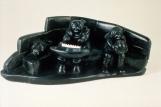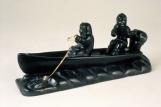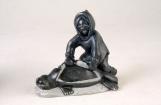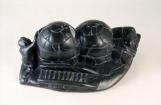1
Jimmy Arnamissak1986
The Guild Shop, Toronto, Ontario, Canada
 Credits:
Credits:Photo: La Fédération Coopératives du Nouveau-Québec
2
Jimmy Arnamissak [1946 - 2003]"I've been told by a qallunaaq that the Inuit land is thought of as a land of soapstone. It seems that is how southerners think of the North, when in fact it is very difficult to get because we have so much snow in the winter. The only time to try and get soapstone is when the snow has melted" (Inuit Art Quarterly [IAQ] 1997:28).
"The art that is made throughout the world will never be lost. Being able to leave something that people remember you by long after you've passed on is something to look forward to. I am happy that I will be able to leave something of myself after I die..." (ibid., 29).
His story
Jimmy Arnamissak-also known as "Jimmy Smith," a nickname derived from his birthplace - was born in 1946 at Cape Smith (now Akulivik). He later moved to Puvirnituq, before settling in Inukjuak. It was in the Akulivik area that his father was killed during a hunting trip, leaving his mother Louisa to support the family. To supplement his mother's pension Arnamissak began carving in 1959 when he was around 12 years old. "Because I had no father I had to think of some way to earn money. By watching and learning from other Inuit - including his mother and brother, Simeonie - who were carving, I started to make carvings and have ever since," he said during an interview with Inuit Art Foundation in 1997. Apart from a brief period in the 1970s, when he worked as the manager of the cooperative in Inukjuak, Arnamissak devoted himself to carving full-time. He was also a skilled hunter, a subject he depicted in many of his sculptures. In 1984, he travelled to Tokyo to participate in an exhibition at the Canadian Trade Centre, an event sponsored by La Fédération des Coopératives du Nouveau-Québec. In 1986, Arnamissak's work was included in an exhibition of Inuit and African soapstone carving that was shown in the Kisii district of Western Kenya. He was subsequently invited to work in the Kenyan village of Tabacca in August as part of an exchange with Kisii carvers. Since 1966, his work has appeared in over 50 group exhibitions and several solo exhibitions. His work can be found in private and public collections throughout North America.
His art
Along with hunting, Jimmy Arnamissak's mother Louisa, who died in 1975, was a subject of many of his sculptures. Louisa's facial features can be seen in his carvings of female figures and many of his works were based on the theme of the active mother and wife busily engaged in domestic activities. He is also well known for his scenes of northern life, which often include groupings of people, kayaks, dogteams, igloos, and komatiit (sleds) arranged on flat, oblong bases. With their smooth contours and compact arrangements, Arnamissak's detailed carvings convey a strong sense of activity and narrative. Sometimes, he also used ivory inlay for the faces of his figures. He often included snowmobiles as part of his vignettes, partly because he regularly travelled hundreds of miles to find and quarry stone. "I enjoy looking for soapstone because it is the best kind of rock. We have never used machinery like bulldozers to extract soapstone; the only tools we use are shovels, so it's a bit of a hardship." His wife, Winnie Naluktuk, told Inuit Art Foundation staff in Inukjuak in 2009 that her favourite piece by her husband is Family Travelling Around the World.
References
Craig, Mary
1987 "Inuit and Kenyan Artists Share Experiences," Inuit Art Quarterly (IAQ), vol. 2, no. 4 (spring): 10
Inuit Art Quarterly (IAQ)
1998 "Jimmy Arnamissak: 'I am happy to leave something of myself'," vol. 13, no. 3 (fall):45
1997 "Jimmy Arnamissak: 'Leaving something that people remember you by'," vol. 12, no. 1(spring):26-29
5
"Man Making Sculpture" by Jimmy Arnamissak1986
Inukjuak, Quebec, Canada
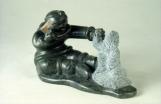 Credits:
Credits:Photo: Paul von Baich
6
"Hunter Harpooning a Walrus" by Jimmy Arnamissak1986
Inukjuak, Quebec, Canada
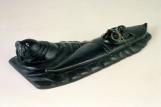 Credits:
Credits:Photo: Paul von Baich
10
"Mother and Child with Kudlik" by Jimmy Arnamissak1986
Inukjuak, Quebec, Canada
 Credits:
Credits:Photo: Art Gallery of Ontario
11
"Family Travelling around the World" by Jimmy Arnamissak1987
Inukjuak, Quebec, Canada
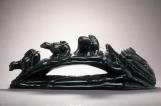 Credits:
Credits:Photo: Art Gallery of Ontario
12
"Man Fishing" by Jimmy Arnamissak1987
Inukjuak, Quebec, Canada
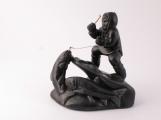 Credits:
Credits:La Fédération Coopératives du Nouveau-Québec
Photo: Bernard Murdoch
14
"Woman Fishing" by Jimmy Arnamissak1991
Inukjuak, Quebec, Canada
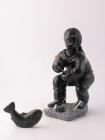 Credits:
Credits:La Fédération Coopératives du Nouveau-Québec
Photo: Bernard Murdoch
